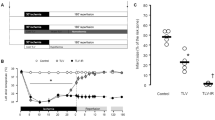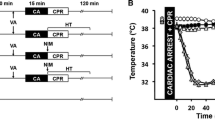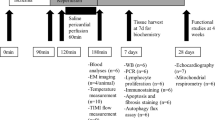Abstract
Cooling the ischemic heart by just a few degrees protects it from infarction without affecting its mechanical function, but the mechanism of this protection is unknown. We investigated whether signal transduction pathways might be involved in the anti-infarct effect of mild hypothermia (35°C). Isolated rabbit hearts underwent 30 min of coronary artery occlusion/2 h of reperfusion. They were either maintained at 38.5°C or cooled to 35°C just before and only during ischemia. Infarct size was measured. The effects of the protein kinase C inhibitor chelerythrine, the nitric oxide synthase inhibitor N ω-nitro-l-arginine methyl ester (l-NAME), the phosphatidylinositol 3-kinase antagonist wortmannin, or either of the mitogen-activated protein kinase kinase 1/2 (MEK1/2) inhibitors PD98059 or U0126 on cooling’s protection were examined. Myocardial ATP assays were performed and the level of phosphorylation of extracellular signal-regulated kinase (ERK) and MEK was examined by western blotting. To investigate an effect of cooling on protein phosphatase (PPase), a PPase inhibitor cantharidin was tested in the infarct model and the effect of mild hypothermia on PP2A activity in vitro was measured. Infarct size was 34.4 ± 2.2% of the ischemic zone in normothermic (38.5°C) hearts, but only 15.6 ± 8.7% in hearts cooled to 35°C during ischemia. Mechanical function was unaffected. Neither chelerythrine, l-NAME, nor wortmannin had any effect, but both PD98059 and U0126 completely eliminated protection. Ischemia rather than reperfusion was the critical time when ERK had to be active to realize protection. Phosphorylation of ERK and MEK fell during normothermic ischemia, but during hypothermic ischemia phosphorylation of ERK remained high while that of MEK was increased. Cooling only slightly delayed the rate at which ATP fell during ischemia, and ERK inhibition did not affect that attenuation suggesting ATP preservation was unrelated to protection. Cantharidin, like cooling, also protected during ischemia but not at reperfusion, and its protection was dependent on ERK phosphorylation. However, mild hypothermia had a negligible effect on PP2A activity in an in vitro assay. Hence, mild hypothermia preserves ERK and MEK activity during ischemia which somehow protects the heart. While a PPase inhibitor mimicked cooling’s protection, a direct effect of cooling on PP2A could not be demonstrated.








Similar content being viewed by others
References
Alessi DR, Cuenda A, Cohen P, Dudley DT, Saltiel AR (1995) PD 098059 is a specific inhibitor of the activation of mitogen-activated protein kinase kinase in vitro and in vivo. J Biol Chem 270:27489–27494. doi:10.1074/jbc.270.46.27489
Armstrong SC, Gao W, Lane JR, Ganote CE (1998) Protein phosphatase inhibitors calyculin A and fostriecin protect rabbit cardiomyocytes in late ischemia. J Mol Cell Cardiol 30:61–73. doi:10.1006/jmcc.1997.0572
Broadley KJ, Broome S, Paton DM (1985) Hypothermia-induced supersensitivity to adenosine for responses mediated via A1-receptors but not A2-receptors. Br J Pharmacol 84:407–415
Chien GL, Wolff RA, Davis RF, VanWinkle DM (1994) “Normothermic range” temperature affects myocardial infarct size. Cardiovasc Res 28:1014–1017. doi:10.1093/cvr/28.7.1014
Dae MW, Gao DW, Sessler DI, Chair K, Stillson CA (2002) Effect of endovascular cooling on myocardial temperature, infarct size, and cardiac output in human-sized pigs. Am J Physiol 282:H1584–H1591. doi:10.1152/ajpheart.00980.2001
Duncia JV, Santella JB III, Higley CA, Pitts WJ, Wityak J, Frietze WE, Rankin FW, Sun J-H, Earl RA, Tabaka AC, Teleha CA, Blom KF, Favata MF, Manos EJ, Daulerio AJ, Stradley DA, Horiuchi K, Copeland RA, Scherle PA, Trzaskos JM, Magolda RL, Trainor GL, Wexler RR, Hobbs FW, Olson RE (1998) MEK inhibitors: the chemistry and biological activity of U0126, its analogs, and cyclization products. Bioorg Med Chem Lett 8:2839–2844. doi:10.1016/S0960-894X(98)00522-8
Duncker DJ, Klassen CL, Ishibashi Y, Herrlinger SH, Pavek TJ, Bache RJ (1996) Effect of temperature on myocardial infarction in swine. Am J Physiol 270:H1189–H1199
Fan WJ, van Vuuren D, Genade S, Lochner A (2010) Kinases and phosphatases in ischaemic preconditioning: a re-evaluation. Basic Res Cardiol 105:495–511. doi:10.1007/s00395-010-0086-3
Götberg M, Olivecrona GK, Engblom H, Ugander M, van der Pals J, Heiberg E, Arheden H, Erlinge D (2008) Rapid short-duration hypothermia with cold saline and endovascular cooling before reperfusion reduces microvascular obstruction and myocardial infarct size. BMC Cardiovasc Disord 8:7. doi:10.1186/1471-2261-8-7
Gustafsson ÅB, Gottlieb RA (2008) Heart mitochondria: gates of life and death. Cardiovasc Res 77:334–343. doi:10.1093/cvr/cvm005
Haendchen RV, Corday E, Meerbaum S, Povzhitkov M, Rit J, Fishbein MC (1983) Prevention of ischemic injury and early reperfusion derangements by hypothermic retroperfusion. J Am Coll Cardiol 1:1067–1080. doi:10.1016/S0735-1097(83)80109-0
Hale SL, Dave RH, Kloner RA (1997) Regional hypothermia reduces myocardial necrosis even when instituted after the onset of ischemia. Basic Res Cardiol 92:351–357. doi:10.1007/s003950050044
Hale SL, Kloner RA (1997) Myocardial temperature in acute myocardial infarction: protection with mild regional hypothermia. Am J Physiol 273:H220–H227
Hausenloy DJ, Baxter G, Bell R, Bøtker HE, Davidson SM, Downey J, Heusch G, Kitakaze M, Lecour S, Mentzer R, Mocanu MM, Ovize M, Schulz R, Shannon R, Walker M, Walkinshaw G, Yellon DM (2010) Translating novel strategies for cardioprotection: the Hatter Workshop Recommendations. Basic Res Cardiol 105:677–686. doi:10.1007/s00395-010-0121-4
Hausenloy DJ, Tsang A, Mocanu MM, Yellon DM (2005) Ischemic preconditioning protects by activating prosurvival kinases at reperfusion. Am J Physiol 288:H971–H976. doi:10.1152/ajpheart.00374.2004
Hausenloy DJ, Yellon DM (2004) New directions for protecting the heart against ischaemia-reperfusion injury: targeting the Reperfusion Injury Salvage Kinase (RISK)-pathway. Cardiovasc Res 61:448–460. doi:10.1016/j.cardiores.2003.09.024
Hausenloy DJ, Yellon DM, Mani-Babu S, Duchen MR (2004) Preconditioning protects by inhibiting the mitochondrial permeability transition. Am J Physiol 287:H841–H849. doi:10.1152/ajpheart.00678.2003
Herbert JM, Augereau JM, Gleye J, Maffrand JP (1990) Chelerythrine is a potent and specific inhibitor of protein kinase C. Biochem Biophys Res Commun 172:993–999. doi:10.1016/0006-291X(90)91544-3
Heusch G, Boengler K, Schulz R (2008) Cardioprotection: nitric oxide, protein kinases, and mitochondria. Circulation 118:1915–1919. doi:10.1161/CIRCULATIONAHA.108.805242
Heusch G, Boengler K, Schulz R (2010) Inhibition of mitochondrial permeability transition pore opening: the holy grail of cardioprotection. Basic Res Cardiol 105:151–154. doi:10.1007/s00395-009-0080-9
Honkanen RE (1993) Cantharidin, another natural toxin that inhibits the activity of serine/threonine protein phosphatases types 1 and 2A. FEBS Lett 330:283–286. doi:10.1016/0014-5793(93)80889-3
Jones RN, Reimer KA, Hill ML, Jennings RB (1982) Effect of hypothermia on changes in high-energy phosphate production and utilization in total ischemia. J Mol Cell Cardiol 14(Suppl 3):123–130
Kanemoto S, Matsubara M, Noma M, Leshnower BG, Parish LM, Jackson BM, Hinmon R, Hamamoto H, Gorman JH III, Gorman RC (2009) Mild hypothermia to limit myocardial ischemia–reperfusion injury: importance of timing. Ann Thorac Surg 87:157–163. doi:10.1186/1471-2261-8-7
Kim SO, Baines CP, Critz SD, Pelech SL, Katz S, Downey JM, Cohen MV (1999) Ischemia induced activation of heat shock protein 27 kinases and casein kinase 2 in the preconditioned rabbit heart. Biochem Cell Biol 77:559–567. doi:10.1139/bcb-77-6-559
Ly HQ, Denault A, Dupuis J, Vadeboncoeur A, Harel F, Arsenault A, Gibson CM, Bonan R (2005) A pilot study: the Noninvasive Surface Cooling Thermoregulatory System for Mild Hypothermia Induction in Acute Myocardial Infarction (The NICAMI Study). Am Heart J 150:933.e9–933.e13. doi:10.1016/j.ahj.2005.02.049
Maeng M, Mortensen UM, Kristensen J, Kristiansen SB, Andersen HR (2006) Hypothermia during reperfusion does not reduce myocardial infarct size in pigs. Basic Res Cardiol 101:61–68. doi:10.1007/s00395-005-0550-7
Masino SA, Dunwiddie TV (1999) Temperature-dependent modulation of excitatory transmission in hippocampal slices is mediated by extracellular adenosine. J Neurosci 19:1932–1939. doi:10.1016/S0306-4522(99)00404-2
Miki T, Liu GS, Cohen MV, Downey JM (1998) Mild hypothermia reduces infarct size in the beating rabbit heart: a practical intervention for acute myocardial infarction? Basic Res Cardiol 93:372–383. doi:10.1007/s003950050105
National Research Council (1996) Guide for the care and use of laboratory animals, 7th edn. National Academy Press, Washington, DC
Ni L, Swingle MS, Bourgeois AC, Honkanen RE (2007) High yield expression of serine/threonine protein phosphatase type 5, and a fluorescent assay suitable for use in the detection of catalytic inhibitors. Assay Drug Dev Technol 5:645–653. doi:10.1089/adt.2007.079
O’Neill WW, Dixon SR (2004) The year in interventional cardiology. J Am Coll Cardiol 43:875–890. doi:10.1016/j.jacc.2003.12.024
O’Neill WW, Dixon SR, Grines CL (2005) The year in interventional cardiology. J Am Coll Cardiol 45:1117–1134. doi:10.1016/j.jacc.2005.01.006
Powis G, Bonjouklian R, Berggren MM, Gallegos A, Abraham R, Ashendel C, Zalkow L, Matter WF, Dodge J, Grindey G, Vlahos CJ (1994) Wortmannin, a potent and selective inhibitor of phosphatidylinositol-3-kinase. Cancer Res 54:2419–2423. doi:10.1007/BF00686043
Shao Z-H, Chang W-T, Chan KC, Wojcik KR, Hsu C-W, Li C-Q, Li J, Anderson T, Qin Y, Becker LB, Hamann KJ, Vanden Hoek TL (2007) Hypothermia-induced cardioprotection using extended ischemia and early reperfusion cooling. Am J Physiol 292:H1995–H2003. doi:10.1152/ajpheart.01312.2005
Shao Z-H, Sharp WW, Wojcik KR, Li C-Q, Han M, Chang W-T, Ramachandran S, Li J, Hamann KJ, Vanden Hoek TL (2010) Therapeutic hypothermia cardioprotection via Akt- and nitric oxide-mediated attenuation of mitochondrial oxidants. Am J Physiol 298:H2164–H2173. doi:10.1152/ajpheart.00994.2009
Simkhovich BZ, Hale SL, Kloner RA (2004) Metabolic mechanism by which mild regional hypothermia preserves ischemic tissue. J Cardiovasc Pharmacol Ther 9:83–90. doi:10.1177/107424840400900203
Skyschally A, van Caster P, Boengler K, Gres P, Musiolik J, Schilawa D, Schulz R, Heusch G (2009) Ischemic postconditioning in pigs: no causal role for RISK activation. Circ Res 104:15–18. doi:10.1161/CIRCRESAHA.108.186429
Solenkova NV, Solodushko V, Cohen MV, Downey JM (2006) Endogenous adenosine protects preconditioned heart during early minutes of reperfusion by activating Akt. Am J Physiol 290:H441–H449. doi:10.1152/ajpheart.00589.2005
Swingle M, Ni L, Honkanen RE (2007) Small molecule inhibitors of ser/thr protein phosphatases: specificity, use and common forms of abuse. Methods Mol Biol 365:23–38. doi:10.1385/1-59745-267-X:23
Tissier R, Hamanaka K, Kuno A, Parker JC, Cohen MV, Downey JM (2007) Total liquid ventilation provides ultra-fast cardioprotective cooling. J Am Coll Cardiol 49:601–605. doi:10.1016/j.jacc.2006.09.041
Weinbrenner C, Baines CP, Liu G-S, Armstrong SC, Ganote CE, Walsh AH, Honkanen RE, Cohen MV, Downey JM (1998) Fostriecin, an inhibitor of protein phosphatase 2A, limits myocardial infarct size even when administered after onset of ischemia. Circulation 98:899–905
Wunder F, Buehler G, Hüser J, Mundt S, Bechem M, Kalthof B (2007) A cell-based nitric oxide reporter assay useful for the identification and characterization of modulators of the nitric oxide/guanosine 3′,5′-cyclic monophosphate pathway. Anal Biochem 363:219–227. doi:10.1016/j.ab.2007.02.001
Yang X-M, Krieg T, Cui L, Downey JM, Cohen MV (2004) NECA and bradykinin at reperfusion reduce infarction in rabbit hearts by signaling through PI3K, ERK, and NO. J Mol Cell Cardiol 36:411–421. doi:10.1016/j.yjmcc.2003.12.008
Acknowledgments
This study was supported in part by a grant from the National Institutes of Health, Heart, Lung, and Blood Institute HL-20648.
Conflict of interest
None.
Author information
Authors and Affiliations
Corresponding author
Rights and permissions
About this article
Cite this article
Yang, X., Liu, Y., Yang, XM. et al. Cardioprotection by mild hypothermia during ischemia involves preservation of ERK activity. Basic Res Cardiol 106, 421–430 (2011). https://doi.org/10.1007/s00395-011-0165-0
Received:
Revised:
Accepted:
Published:
Issue Date:
DOI: https://doi.org/10.1007/s00395-011-0165-0




